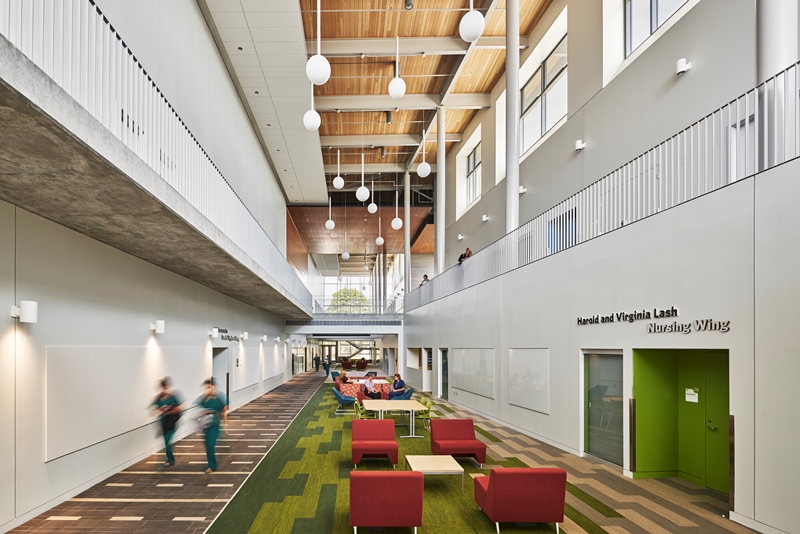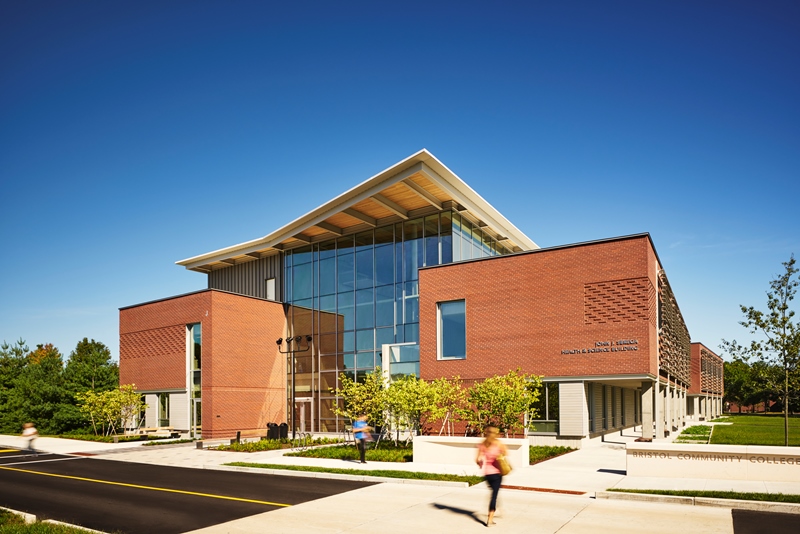Project Description:
The John J. Sbrega Health and Science Building is a shared resource occupied by multiple disciplines within the Sciences and Health Professions disciplines at Bristol Community College. The facility represents the translation of basic science to its application in the health professions. For the sciences, the building accommodates flexible instructional labs and support space for field biology, biotech, microbiology, and general chemistry. The health professions are represented by nursing skills and simulation labs, clinical laboratory science and medical assisting labs, dental hygiene labs and teaching clinic, which provides care to underserved populations.
These spaces are organized around a common, light-filled learning commons and student living room, meant to invite a broader set of users to the building as a place to study and otherwise learn in more informal ways. The walls separating lab spaces from the atrium are glazed, with a combination of opaque markerboard glass and clear glass, allowing for views into the labs and putting science on display.
The 50,600 square foot building serves traditionally energy-dense uses, including a large number of fume hoods, high plug loads, and specific ventilation and lighting requirements. An initial basis of design called for a high-performance building with numerous energy-conservation measures in order to meet the requirement that state-owned buildings be Massachusetts LEED Silver Plus, including a minimum of 20% energy cost-reduction relative to code.
While the project paused for funding in 2012, the College intensified its ACUPCC commitment to carbon neutrality by 2050, initiating plans to build a site-based 3.2 megawatt solar array. This new context presented an opportunity to reassess the original "high-performance" design, which, according to the energy model, would not keep pace with BCC's 2050 commitment, using at least 50% of the power generated by the solar array and enough natural gas to heat two hundred homes. The team made a strategic investment to develop a Zero Net Energy (ZNE) design, which would balance annual energy consumption with renewable energy generated on site. With few comparable built examples, the question was: how to achieve ZNE for an energy-dense program in a cold climate?
A number of options were tested using simulations, calculations, research, and discussions with manufacturers of advanced building technologies. Ultimately, a holistic combination of technologies and strategies were developed, including dramatically reduced lighting and plug loads, a high-performance envelope, natural ventilation systems, wider indoor temperature range, localized cooling, filtration fume hoods, air quality sensing, reduced air changes, enthalpy wheel heat recovery, and a hybrid-source heat pump system. Enhanced monitoring and verification will help to ensure efficient ongoing operation. The resultant design is projected to use less than 20% of the new array and no fossil fuels for heating and cooling. Significantly, the ZNE design was achieved without increasing the budget, serving as an important benchmark for future campus development and a model for other institutions.
Building Type Summary:
Other Awards:
MA DOER Leading by Example Award, 2014
ASHRAE Region 1 Award for Engineering Excellence, 2014
Community College Futures Assembly Bellwether Award Finalist, 2014
NACUBO Innovation Award, 2015
I2SL Go Beyond Award, 2016
Address:
Elevation:
Lat. / Long.:
Location Type:
Köppen Climate Type:
Climate Region:
HDD Base Temp:
CDD Base Temp:
Occupancy Type and Details:
Owner occupied
28: FTE
292: Peak transient occupants/day
90: operating hours/wk
Conditioned Floor Area:
Conditioned Building Volume:
Semiconditioned Floor Area:
Unconditioned Floor Area:
Multiple buildings?:
Total number of units in project (all buildings):
Total floor area of project (all buildings):
Historic?:
Completion date:
Site description:
The building and landscape is situated at a prominent, highly visible campus threshold at the intersection of the campus and public realms. The site also cradles the primary campus lawn and significant grove of oak trees and is a focal point for all surrounding buildings. Lastly, the site resides at a critical stormwater juncture on campus and seamlessly integrates new and existing stormwater features
Energy Highlights:
The design utilizes ground-source heat pumps to satisfy 100% of the building's heating requirement and natural ventilation in the atrium.
LCA Description:
The design and energy team has performed a life-cycle cost analysis for several additional energy conservation measures to be considered for inclusion in the project. A life-cycle cost analysis is used to estimate the total cost of ownership including construction costs, maintenance costs and energy-costs. Through this analysis, well informed decisions can be made.
Annual renewable energy generated:
Electric Utility Company:
Gas Utility Company:
Datasets and Utility Bills sources and reliability:
Utility consumption will be metered via the BAS which contains points for all the utility meters and submeters installed in the building. Reliability is high.
Electricity amount (imported from grid):
Electricity amount (credited or exported to grid):
Net electricity usage (purchased electricity):
Natural gas amount (purchased energy):
Subslab assembly:
Slab on grade - 6" th.
Vapor barrier
XPS insulation 24" wide at perimeter - 2"
Foundation wall assembly:
Foundation wall is essentially a frost wall. There is no basement. It is not insulated.
Above grade wall assembly:
Cladding (brick, wood, metal panel)
Air space
Mineral wool insulation, 3.5" th.
Air/vapor barrier
Gypsum board sheathing
Studs with mineral wool insulation, 6" th.
Door Area:
Space heating - Manufacturer & Model:
Space heating - capacity:
Space cooling - Manufacturer & Model:
Space cooling - capacity:
Domestic hot water - Manufacturer & Model:
Domestic hot water - capacity:
Domestic hot water - efficiency:
Ventilation - Manufacturer & Model:
Design for Adaptability:
Modular planning
Other Software tools:
Revit (BIM)
Energy Modeling Software:
eQuest v3.64
Total Cost of Project:
Construction hard cost:
Utility incentives:
Incentives are subject to a final inspection by National Grid. We should have a final number early in 2017.
Annual Electric Savings:
Annual Revenue from SRECs or other renewable energy credits:
Published References:
Lab Design, “A Zero Net Energy Teaching Lab”, 12/8/14 (https://www.labdesignnews.com/article/2014/12/zero-net-energy-teaching-lab)
South Coast Today, “Education: Bristol Community College earns Innovation Award”, 8/16/2015 (http://www.southcoasttoday.com/article/20150816/SPECIAL/150819885)
School Construction News, “Bristol Community College to Debut Net-Zero Facility”, 1/21/2016 (http://www.schoolconstructionnews.com/articles/2016/01/21/bristol-commun...)
Fall River Herald News, “BCC's new eco-friendly health and sciences building is shaping up”, 2/25/2016 (http://www.heraldnews.com/news/20160225/bccs-new-eco-friendly-health-and...)
South Coast Almanac, “ Bristol Community College’s Cutting Edge Design”, 7/14/2016 (http://southcoastalmanac.com/2016/07/14/bristol-community-colleges-cutti...)
College Planning & Management, “Zero Net Energy, Zero Added Cost”, 10/1/2016 (https://webcpm.com/articles/2016/10/01/zero-net-energy.aspx)
Prism, “New England’s first Zero Net Energy academic lab science building”, 10/12/2016 (https://prismpub.com/new-englands-first-zero-net-energy-academic-lab-sci...)
Tradeline, “John J. Sbrega Health and Science Building”, 11/16/2016 (https://www.tradelineinc.com/reports/2016-11/john-j-sbrega-health-and-sc...)
Special architectural measures:
1. High performance envelope: increased r-value, air-tightness,
2. Third party envelope commissioning
3. Whole building blower door testing (tested 50% tighter than spec and just above 'passive house' standards).
4. Self shading (overhangs and glazing)
5. Natural ventilation
6. Daylighting (including labs and classrooms borrowing light from the atrium)
Energy Strategies:
A ground-source vertical-well heat pump system provides the building's entire heating load and an equivalent amount of cooling, depending on the annual energy balance. Air-source heat pumps provide the remainder of the cooling requirement and are used to balance the extraction/rejection of heat from the ground. The air-side system consists of a dedicated outside air unit with a total energy recovery heat wheel to precondition the outside air and fan-coil units within the spaces to provide heating and cooling, thereby completely decoupling space conditioning from ventilation. Aggressive internal load reduction, filtered fume hoods, and natural ventilation are also employed to reduce the energy consumption of the building.
Subslab R-value:
Above grade wall R-value:
Average window U-factor:
Solar Heat Gain Coefficient:
Visible Light Transmittance:
Door U-Factor:
Cost per square foot of Conditioned Space:
Project Photos:



Number of Bathrooms:
Scope Description:
The building is an instructional laboratory building for above grade 12. The usage breakdown is as follows:
80% Laboratory/lab support/classroom
13% Lobby and shared social space
4% Office
2% Other
The net assignable square footage is 27,360, distributed on two floors. The building accommodates labs for biology, chemistry, dental hygiene, nursing, clinical laboratory science, and medical assisting. Mechanical space is 7,200sf, or 14% of the gross area.
The project include considerable site improvements across 183,338sf. The breakdown of those improvements is as follows:
39% Restored landscape
18% Other
15% Drives/roadway
14% Pedestrian/non-motorized vehicle path
9% Garden--decorative
4% Patio/hardscape
1% Shade structures/outdoor rooms
Site conditions:
Renewable Energy Sources:
Other Purchased Fuels Description:
Gas is not used to power the building. It is available for the back-up boiler, emergency generator, back-up hot water, and laboratory use.
Summary of enclosure strategy/description:
The envelope consists of a number of assemblies. Window to wall ratio is 22%.
Wall assemblies are a combination of stud and mass wall. The approach to stud assemblies to fill the stud cavity with mineral wool insulation and put 3 inches of mineral wool insulation outboard of the vapor barrier. The approach at mass walls is similar, except that the stud cavity, which is shallower, is filled with foam-in-place insulation.
The air-vapor barrier is continuous, with carefully designed transitions and tie-ins at openings.
Roof Assembly:
Modified bituminous membrane roofing
Cover board
Polyisocyanurate insulation, 4" th. min.
Vapor barrier
Thermal board
Wood decking
Roof R-value:
Window Description:
Curtainwall
Aluminum
Kawneer
1600UT
Storefront
Aluminum
Kawneer
451UT
Door Description:
Aluminum
Kawneer
500
Number of Bedrooms:
Team Members:
Steve Kenyon, Bristol Community College, VP for Finance and Administration
Leo Racine, Director of Capital Projects
Barry Heidke, Division of Capital Asset Management and Maintenance, Project Manager
Jeff Freitas, Division of Capital Asset Management and Maintenance, Project Engineer
Fiske Crowell, FAIA, Sasaki, Architect
James Moses, AIA, Sasaki, Architect
Anthony Petone, PE, BR+A, Mechanical Engineer
Predrag Ciric, PE, BR+A, Electrical Engineer
Jacob Knowles, BR+A, Director of Sustainability
Paul Ormond, Haley and Aldrich, Geothermal Engineer
Nicole Holmes, Nitsch Engineering, Civil Engineer
Ian Scherling, Sasaki, Landscape Architect
Kenneth Johnson, Bond Brothers, Construction Manager
Steve Liechti, Bond Brothers, Construction Manager

Mechanical Equipment Installation Details and Comments:
Complete construction administration and commissioning process. Also studied BAS dashboard output related to systems to ensure proper operation.